Telehealth Reverse Diabetes With Unsaturated Fat

Intake of polyunsaturated fat improves lean tissue formation, increases skeletal muscle insulin sensitivity and decreases insulin resistance.
Low carbohydrate intake with low calorie count undoubtedly lowers body weight in the short term. Exchanged with high animal fat and protein, low carb intake decreases body weight but increases mortality rates in the long term.
Exchanging with plant based fat and protein, intentional low carb, low calorie intake still lowers body weight while reducing mortality. Polyunsaturated fatty acids produce the most consistent favorable effects.
To learn more about programs Herd Healthcare offers, our website is:
www.herdhealthcare.com
Effects Of Food On Cellular Metabolism
What we eat affects our health. We know that. Certainly, overeating more than we need causes overweight and obesity. For some people, even a little overweight is enough to cause type 2 diabetes.
The type of food also affects our health. How much energy we get from carbohydrate, how much from protein and how much from fat is about equally divided for most of us. Probably more carbohydrate and less protein than ideal, but we don’t give it much attention.
Unless we’re trying to lose weight. Then we tend to decrease carbohydrates and fats while maintaining or increasing intake of protein. We do it by decreasing food intake every meal, every day or by intermittently fasting. During the day or during the week.
Does it matter how? The answer is, “Yes, it matters.” Protein intake must be maintained to prevent loss of skeletal muscle during intentional loss of weight. We need about 0.7 grams per pound of ideal weight per day to build, maintain and repair skeletal muscle.
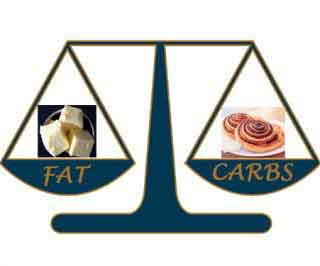 How much fat and how much carbohydrate is less well established. Both affect cellular metabolism. Carbohydrate appears in our food as sugar, starch and fiber. Fat exists in saturated, monounsaturated and polyunsaturated forms. Proportions of carbohydrate and all types of fat affect levels of sugar and fat as well as levels of insulin in our blood.
How much fat and how much carbohydrate is less well established. Both affect cellular metabolism. Carbohydrate appears in our food as sugar, starch and fiber. Fat exists in saturated, monounsaturated and polyunsaturated forms. Proportions of carbohydrate and all types of fat affect levels of sugar and fat as well as levels of insulin in our blood.
Effects Of Dietary Fats And Carbohydrates On Metabolism
The ideal balance of fats and carbohydrates in our food is controversial. Most controversy arises in relation to intentional weight reduction. But first we need to know the best balance when body weight is unchanged.
Studies of the ideal balance have been made. Results have been reported from 102 clinical trials involving 4,660 subjects. In these trials, meals with various types and amounts of fat were substituted for carbohydrates. All subjects had diabetes or prediabetes but none were taking medications or injecting insulin for treatment. Subjects did not gain or lose weight during studies lasting 4 to 40 weeks.
Measurements were made of sugar and fat as well as levels of insulin in blood. Values were measured before and during 2-hour oral glucose tolerance tests. These tests were run before and after substituting carbohydrates with isocaloric amounts of saturated fatty acids (SFA) and polyunsaturated fatty acids (PUFA). Measures also were made before and after substituting isocaloric amounts of PUFA for SFA.
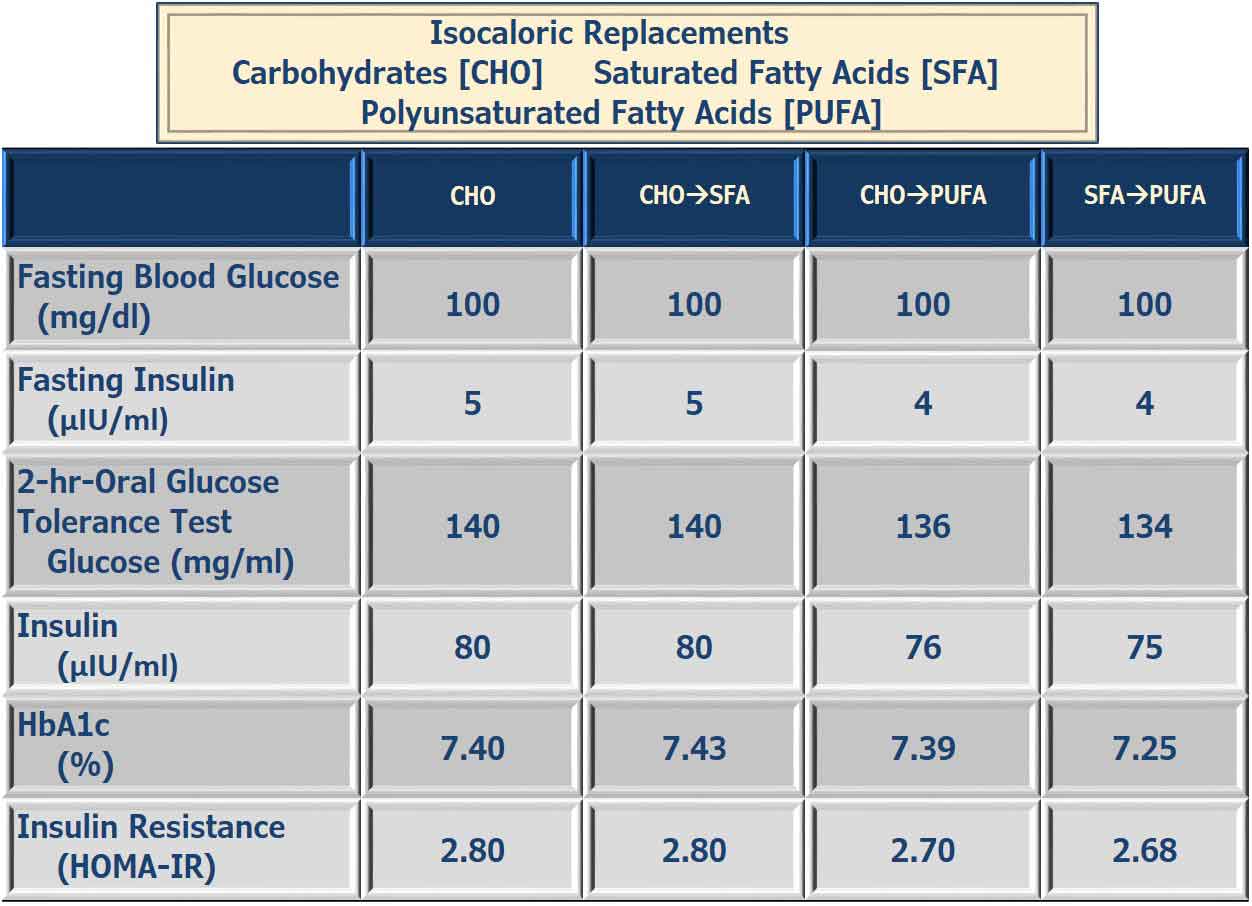
As shown in the Table, there were no significant changes in fasting blood sugar values or levels of insulin.
Also, there were no significant changes in oral glucose tolerance tests when SFA was substituted for substantial portions of carbohydrates.
Replacing portions of carbohydrates with PUFA did increase insulin sensitivity. Oral intake of glucose caused less rise in blood glucose values and less increase in insulin levels. Also, replacing SFA with PUFA caused a similar improvement in glucose tolerance.
During the studies, replacing carbohydrates and SFA with PUFA caused the most reduction in HbA1c. That substitution also caused the greatest reduction of insulin resistance.
These results illustrate a benefit from substituting polyunsaturated fats from vegetable sources for animal fats or processed grains, starches and sugars.
Different Effects SFA And PUFA On Fat And Lean Tissue
Overeating excess calories from fat increases total body weight. Where the excess energy is stored affects response to insulin and severity of type 2 diabetes. Different metabolic responses to SFA and PUFA apparently are related to different sites of excess energy storage.
The sites of excess energy storage have been studied by investigators using magnetic resonance imaging. Subjects were 37 healthy young men and women with normal body weight.
They were studied before and after 7 weeks overeating excess calories. One group of 19 subjects were fed excess food baked with SFA. The other 18 subjects were fed excess food baked with PUFA. After 7 weeks all subjects gained an average of 3.5 lb in body weight. This was approximately a 2.5% increase in total body weight.
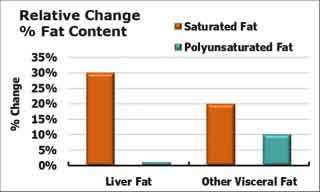 Both groups gained the same amount of weight. Both groups increased subcutaneous fat about 18%. However, as shown in the Figures energy storage between intraabdominal fat and lean tissue was distributed differently in the two groups.
Both groups gained the same amount of weight. Both groups increased subcutaneous fat about 18%. However, as shown in the Figures energy storage between intraabdominal fat and lean tissue was distributed differently in the two groups.
Liver fat was increased 30% in the group fed excess SFA and unchanged in group fed excess PUFA. Visceral fat was increased 20% with SFA and 10% with PUFA.
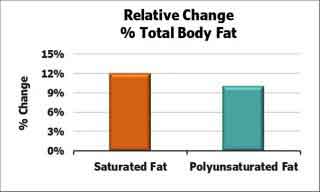
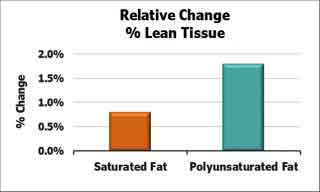
Total body fat was increased 12% in the group fed excess SFA. It was increased less, about 10%, in the group fed excess PUFA. In contrast with excess SFA causing greater increase in total body fat, lean tissue was increased almost 2% in the group fed excess PUFA and less than 1% in the group fed excess SFA.
The differences were significant. Excess SFA had a greater effect increasing intraabdominal fat storage while excess PUFA had a greater effect increasing lean tissue.
Dietary Carbohydrate Intake And Mortality
Intentional low carbohydrate and low total energy intake below total requirements inevitably causes reduction in body weight. Partial offset of energy deficit by substantial increase in fat intake decreases appetite and makes it easier for many people to lose weight. Also, the substitution of energy from fats increases insulin sensitivity and decreases loss of lean body tissue. Increases in fat intake include both saturated and unsaturated types of fat.
The short term benefits have been demonstrated, promoted and commercially exploited. However, the long term effects of low carbohydrate and high saturated fat intake are less well known.
The long term consequences have been studied and analyzed. Effects on mortality apparently depend on whether energy from carbohydrate intake is replaced by plant-based or animal-based fat and protein.
A long term study of 15,428 adults in the US has been analyzed during 25 years. Participants reported the portion sizes and categories of food consumed during one month on 6 occasions approximately 4 years apart. During this study period of 25 years, there were 6,283 deaths.
The Figure shows the relationship between % energy from carbohydrates  consumed and the average ages at death. The Figure also shows an estimate of age at which disability occurred before death. This estimate is based on the assumption that years of disability are approximately twice the years of health lost to premature death.
consumed and the average ages at death. The Figure also shows an estimate of age at which disability occurred before death. This estimate is based on the assumption that years of disability are approximately twice the years of health lost to premature death.
The optimum % calories from carbohydrates in food was approximately 50%.
From an average age of 50 years at recruitment, the highest average age at death was 82 years. Loss of life from premature death for those consuming the lowest % carbohydrates was approximately 4 years. That was about 13.3% of best possible years of life after age 50. Loss of good health was approximately 8 years or about 26.6%. The total of good health years lost after age 50 because of disability and premature death would be 40%.
Different types of fat have different effects on mortality. Dietary analyses from the Nurses’ Health Study and the Health Professionals Follow-up Study show relations to mortality.
The Nurses’ Health Study began in 1976 and is still recruiting new participants. The Health Professionals Follow-up Study began in 1986. Food intake was assessed when each participant enrolled and data were updated every 2 to 4 years. Results have been reported for 126,000 women and men during approximately 32 years from 1980 to 2012.
In each assessment, participants reported how often they had consumed a specified portion size of each specific food during the preceding year. Each assessment used reports of specific brands and types of fat as well as amounts and frequency of use. As a result, information was available to report amounts standardized in population quintiles for daily consumption of saturated fat, monounsaturated fat and polyunsaturated fat.
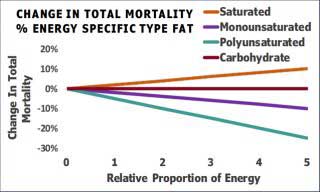 The Figure illustrates the % change in mortality observed when calories from carbohydrates were replaced with calories from each type of fat. As can be seen in the Figure, replacement of carbohydrates with saturated fats increased mortality and decreased years of life. Replacement of carbohydrates with unsaturated fats decreased mortality and increased years of life.
The Figure illustrates the % change in mortality observed when calories from carbohydrates were replaced with calories from each type of fat. As can be seen in the Figure, replacement of carbohydrates with saturated fats increased mortality and decreased years of life. Replacement of carbohydrates with unsaturated fats decreased mortality and increased years of life.
Polyunsaturated fats were most effective in increasing years of life.
Dietary Guidelines
Unsaturated fats eaten in place of saturated fats can reduce the development of cardiovascular disease and all-cause mortality. However, they are still a concentrated source of calories. They must be eaten in place of saturated fat or carbohydrates. Not eaten as extra calories. Dressings and sauces with unsaturated fats are a high density source of additional calories.
Fats supply energy for metabolism and physical work. In addition to supplying energy, they help absorb fat-soluble vitamins needed for many metabolic processes.
When eaten in place of saturated fats, unsaturated fats can lower the levels of total cholesterol and lipoproteins that increase risk for cardiovascular disease.
Polyunsaturated fat supplies two essential fats that are required for normal cellular metabolism. Fats that can’t be made in the human body and must be obtained from food.
Polyunsaturated fats are found in a variety of foods, including:
•Fish (such as herring, mackerel, salmon, trout, and tuna)
•Mayonnaise and oil-based salad dressings
•Nuts (such as pine nuts and walnuts)
•Seeds (such as flax, pumpkin, sesame, and sunflower seeds)
•Soft margarine (liquid, spray, and tub)
•Vegetable oils (such as corn, cottonseed, soybean, and sunflower oils)
General guidelines are to consume no more than 10 grams a day of saturated fats while consuming at least 20 grams of unsaturated fats. This should include at least 5 grams a week of polyunsaturated fats from fish, fish oil or flaxseed oil.
The Nutrition Facts Labels on food and beverage packages are required to show the amount in grams of total fat and saturated fat in one serving of the food. Food manufacturers are not required to list the amounts of monounsaturated and polyunsaturated fats on the Food Label. But you can calculate total unsaturated fats by subtracting the amount of saturated fat from the total fat.
Unsaturated fats are usually liquid at room temperature. Here’s how to use them in your meals and snacks.
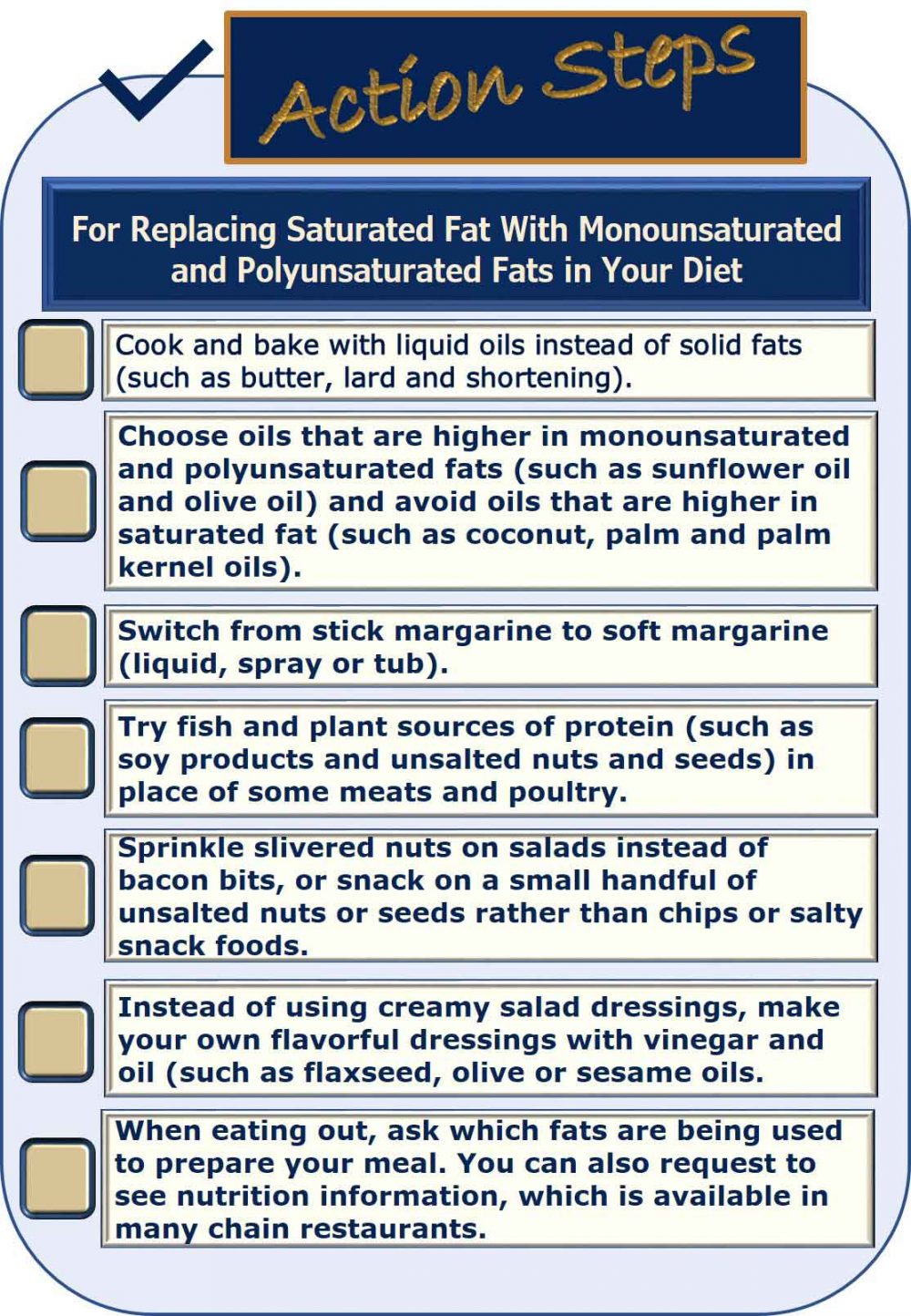
Summary
Fats supply energy for metabolism and physical work. In addition to supplying energy, they help absorb fat-soluble vitamins needed for many metabolic processes.
Intake of polyunsaturated fat improves lean tissue formation, increases skeletal muscle insulin sensitivity and decreases insulin resistance.
Low carbohydrate intake with low calorie count undoubtedly lowers body weight in the short term. Exchanged with high animal fat and protein, low carb intake decreases body weight but increases mortality rates in the long term.
Exchanging with plant based fat and protein, intentional low carb, low calorie intake still lowers body weight while reducing mortality. Polyunsaturated fatty acids produce the most consistent favorable effects.
General guidelines are to consume no more than 10 grams a day of saturated fats while consuming at least 20 grams of unsaturated fats. This should include at least 5 grams a week of polyunsaturated fats from fish, fish oil or flaxseed oil.
Let us help you decrease excess calorie intake while increasing intake of unsaturated fats.

We are pleased to share our blog articles with you, and we are always interested to hear from our readers. Our website address is: www.herdhealthcare.com




